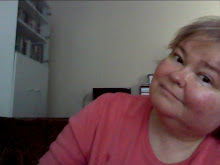 Easter at Anna's. There was an Easter celebration and dinner at my place. Dad, Linda, Yalda, Olivia, Jonathon, Jo-Ann, Toran & Aurelia were the all there.
Easter at Anna's. There was an Easter celebration and dinner at my place. Dad, Linda, Yalda, Olivia, Jonathon, Jo-Ann, Toran & Aurelia were the all there.
The three children decorated sugar cookies in Easter shapes for the adults (and themselves) and Yalda brought a champagne cake and champagne!
The children also were delighted to get three separate Easter surprises -- bags from Linda & Yalda, Jo-Ann & Anna, and Dad's handmade baskets. Dad also made baskets for all the adults with a parmesean shaker inside for the treat!
I also shared the interesting information below with everyone, which was sent from Keith & Marie in the UK earlier this morning as an Easter hello.
Some Easter Superstitions
 At the pagan feast of Eostre an ox was sacrificed. The ox’s horns became a symbol for the feast. They were carved into the ritual bread which is where "hot cross buns" originated. The word "buns" is derived from the Saxon word "boun" which means sacred ox. Nowadays the symbol of a cross is used to decorate buns. Hot cross buns are thought to act as a charm against evil. Sailors believed that the buns would protect them against shipwreck if taken to sea. Farmers in many parts of
At the pagan feast of Eostre an ox was sacrificed. The ox’s horns became a symbol for the feast. They were carved into the ritual bread which is where "hot cross buns" originated. The word "buns" is derived from the Saxon word "boun" which means sacred ox. Nowadays the symbol of a cross is used to decorate buns. Hot cross buns are thought to act as a charm against evil. Sailors believed that the buns would protect them against shipwreck if taken to sea. Farmers in many parts of
The goddess Eostre was worshipped by the Anglo-Saxons and her symbols were the egg and the hare so from that we still have the egg and the rabbit or Easter Bunny. Eggs have always been associated with rebirth and continuity.
Mary Magdalene is supposed to have visited the roman Emperor Tiberias and she gave him a red egg as a symbol of the Resurrection - the symbol of new life. It is believed that the Christian tradition of giving eggs to each other at Easter came from this event. For a long time Eggs have been painted in bright colours to celebrate the Spring. Hard-boiled egg rolling contests still take place in some parts of
People would not use nails or iron tools during Easter time. This was because of the nails hammered into Christ’s feet and hands. The planting of crops was never done at Easter because it would mean that metal would enter the ground in the form of a spade or fork.
It was generally believed that it was very unlucky to sweep your house or yard on a Good Friday. Likewise it was also unlucky to sweep dust directly out of the house as you may sweep your good luck out with it. It was considered better to sweep all the dust into the centre of the room and then pick it up and dispose of it from there.
Another unlucky thing was to wash clothes on a Good Friday as nothing good would come of it. This is associated with a story about Christ, who whilst carrying his cross to
On the other hand, it was very lucky to wear new clothes at Easter. It was "deemed essential by many people to wear some new article of dress, if only a pair of gloves or a ribbon, for not to do so is considered unlucky and the birds will be angry with you."
Touching wood is thought by some to be the result of the Christian belief in the Crucifixion. As Christ was sacrificed on a cross of wood touching wood was a sign of deep compassion and reverence for Christ’s resurrection.
The Hawthorn tree is either lucky or unlucky. Some considered it a tree destined to bring bad fortune to the owner as it is thought that this is the tree from which the crown of thorns was made. However, some people believe that the Hawthorn is a very holy plant for exactly the same reason and that cutting down or attacking a Hawthorn will result in terrible misfortune.
A very widespread belief was that when the sun rose on Easter Sunday it danced "for joy". People at Castleton, Derbyshire used to climb the hill on which the castle is built at six o'clock in the morning to see the sun rise. "On this day the sun is said to dance for joy at His rising." Some people would put out pails of water or gathered at rivers or ponds to see the sun dance's reflection. When the sun set on Easter Sunday it was supposed to spin around and people also used to gather to see it turning.










No comments:
Post a Comment